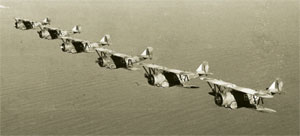
Features
Operations
Looking Back: Grumman Goblin
Under normal circumstances you would not expect to find the Grumman Goblin on any list of famous Canadian aircrafts.
October 2, 2007 By Raymond Canon
 Under normal circumstances you would not expect to find the Grumman
Under normal circumstances you would not expect to find the Grumman
Goblin on any list of famous Canadian aircraft. But if we want to
expand that list to include aircraft considered something of an
anachronism, the Goblin would rank near the top.
Already obsolete when its call for duty came, the Goblin served for a
year as a front-line fighter in the defence of Halifax in case of any
attack by German bombers during the early part ofWorld War II. That it
was even considered for a role as a fighter shows how desperate the
situation was in 1940. The Nazi war machine looked all but invincible
at the time, and a potential air attack on strategic North American
ports such as Halifax was considered a possibility. It was from these
ports that the convoys to Britain set sail. Convoys, it must be
remembered, that were the lifeblood of the besieged island.
The
Goblin was the first of a long line of naval fighters built by Grumman
Aircraft Corporation to be put in service by the US Navy. Conceived in
the 1930s when fighter design was evolving much more rapidly than ever
before, the Goblin did have innovations such as retractable landing
gear, but as a biplane it was already obsolete. Like most of the
company’s products it was solidly built and also somewhat heavy for the
700-hp Wright pistondriven engine that powered it.
Undergunned
and with a top speed of only 207 mph, it was soon overtaken by another
of Grumman’s products, the F2F and – before the end of the decade – the
famous Wildcat. The latter was the first truly successful of the
company’s designs and it bore the brunt of the navy’s aerial battles
when the US entered the war on December 7, 1941.